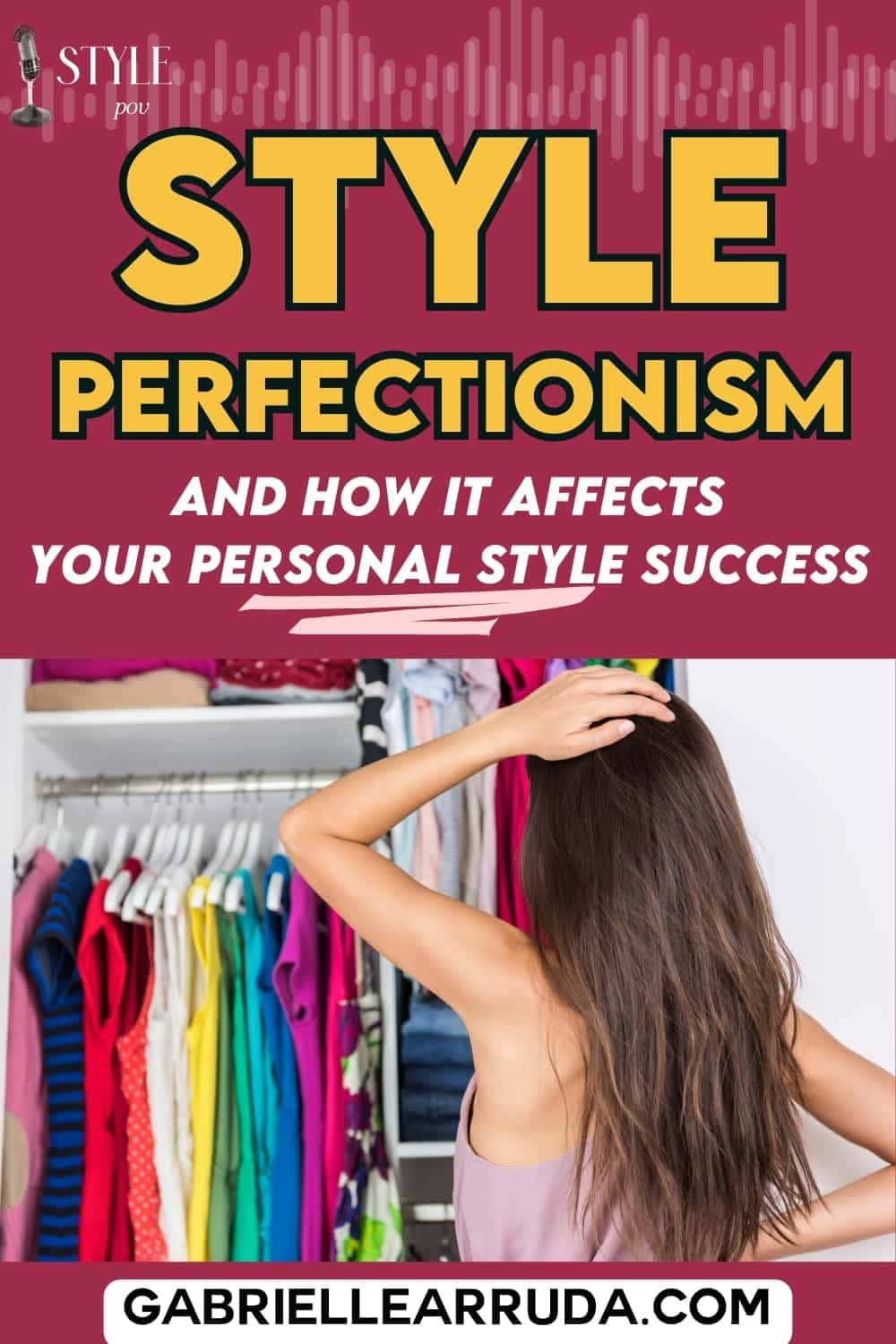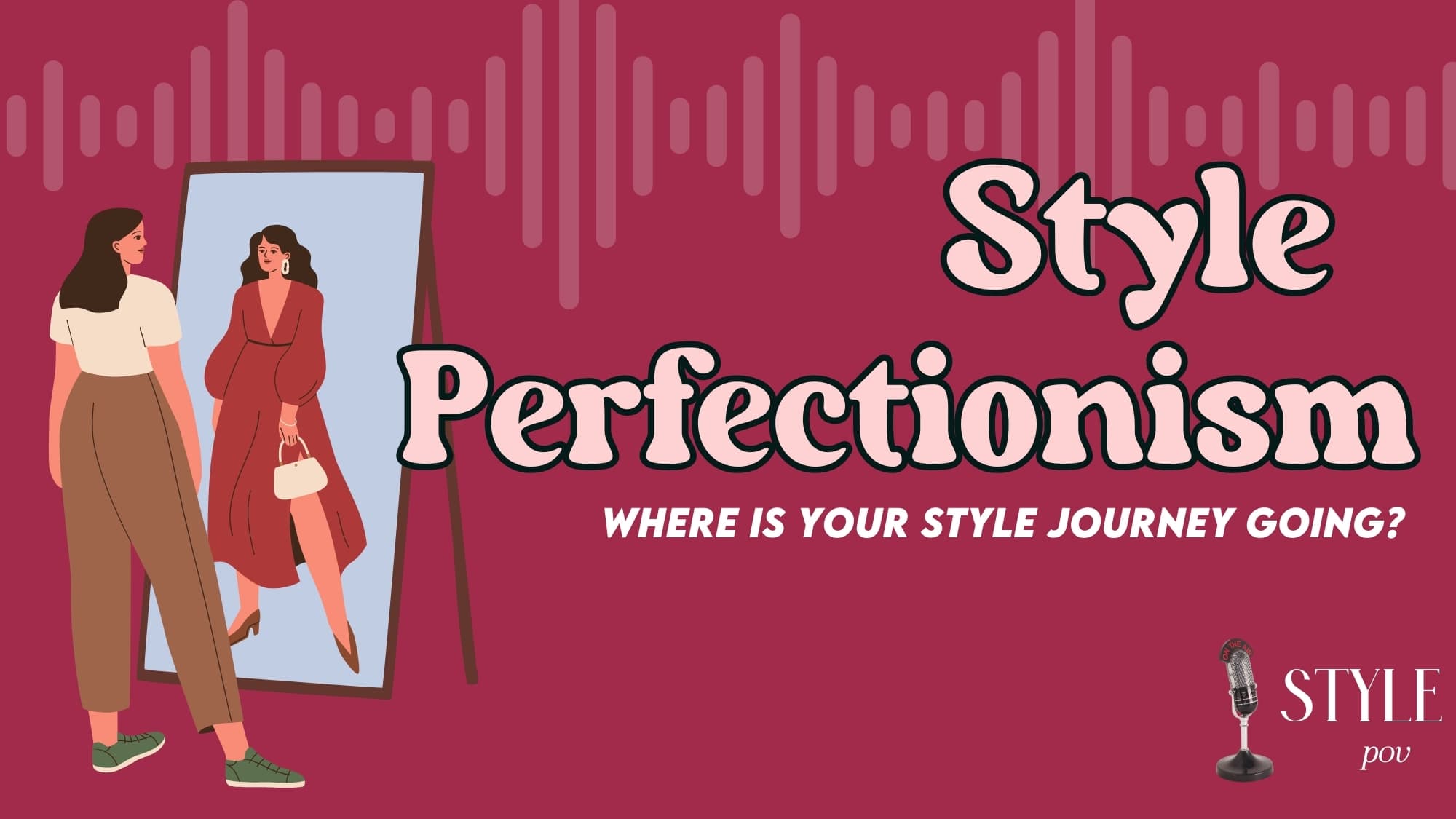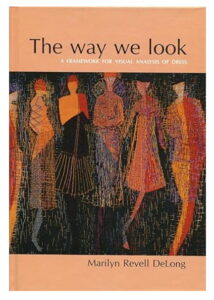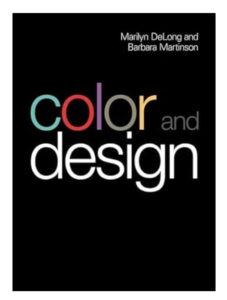The episode discusses the concept of style perfectionism, the importance of setting achievable style goals, and how perfectionism can hinder progress in personal style development. It explores the idea of aiming for 80% completion to avoid procrastination and emphasizes the need to trust one’s fashion instincts to find strength through style.
Listen to it:
Transcript:
We’re better for being perfectionists, right?
Like it’s the one trait we jokingly attribute as our quote, greatest weakness, unquote, as we slyly smile from our perfectly designed ivory towers. Spoiler alert, perfectionism is procrastination.
Hi, I’m Gabrielle Arruda your host for the Style POV podcast and I’m here to help you learn to trust your fashion instincts, hone your authentic style POV, and find strength through style.
The Trap of Style Perfectionism
This episode is all about Style Perfectionism. What is it, how is it thwarting your personal style, and how can you apply better techniques to move towards your own style goal post.
But first, shoutout to one of the members of my free Facebook group, who preferred to remain anonymous, but who approved my request to use her post as inspiration for this episode.
Her post was based on a video by Hank Green, which is linked in the show notes, that basically said 80% done, is good enough. And her takeaway was that 80% of an outfit being there is good enough.
And it got me thinking, as a self-proclaimed type A perfectionist, I wonder if other people are being held back in their style pursuits by trying to always shoot for 100% or get all their style toolbox elements working perfectly.
You know those 15 different style systems and color palettes to blend seamlessly together for every task in their daily life.
The takeaway from Hank’s video was that “ best” is completely subjective, and defining perfect, seem ambiguous…especially so within the hyper-personal lens of personal style.
So why do so many of us get analysis paralysis and shut down when our style expressions aren’t.. perfect.
We may earn a commission from you clicking a link below. And as an amazon associate, we earn on qualifying purchases. Full affiliate policy, here.
The Science Behind the 85% Rule and Its Fashion Implications
Let’s dig into this… I was curious whether or not this 80% number had any tangible proof behind it or whether it was an ambiguous number that Hank said: “ya, that feels about right for me”. Or would others find specifying their own percentage goal more empowering?
And, lo and behold I found a scientific paper (linked in show notes) called the 85% rule. And don’t worry I will always bring this back into the fashion domain, but let me explain this first.
So the 85% rule is based around learning a new skill, and it’s considered the “Goldilocks zone” when the new skill is at the edge of our competence but not so hard we get discouraged. But not so boring we ignore it.
Because we get anxiety when a challenge exceeds our skill too far, and boredom when our skill exceeds the challenge.
But ultimately we want a state of flow– one that encourages complete immersion in the challenge or task but with a deep sense of control. And perfectionists love control, right?
Understanding The Use of Your Style Toolbox
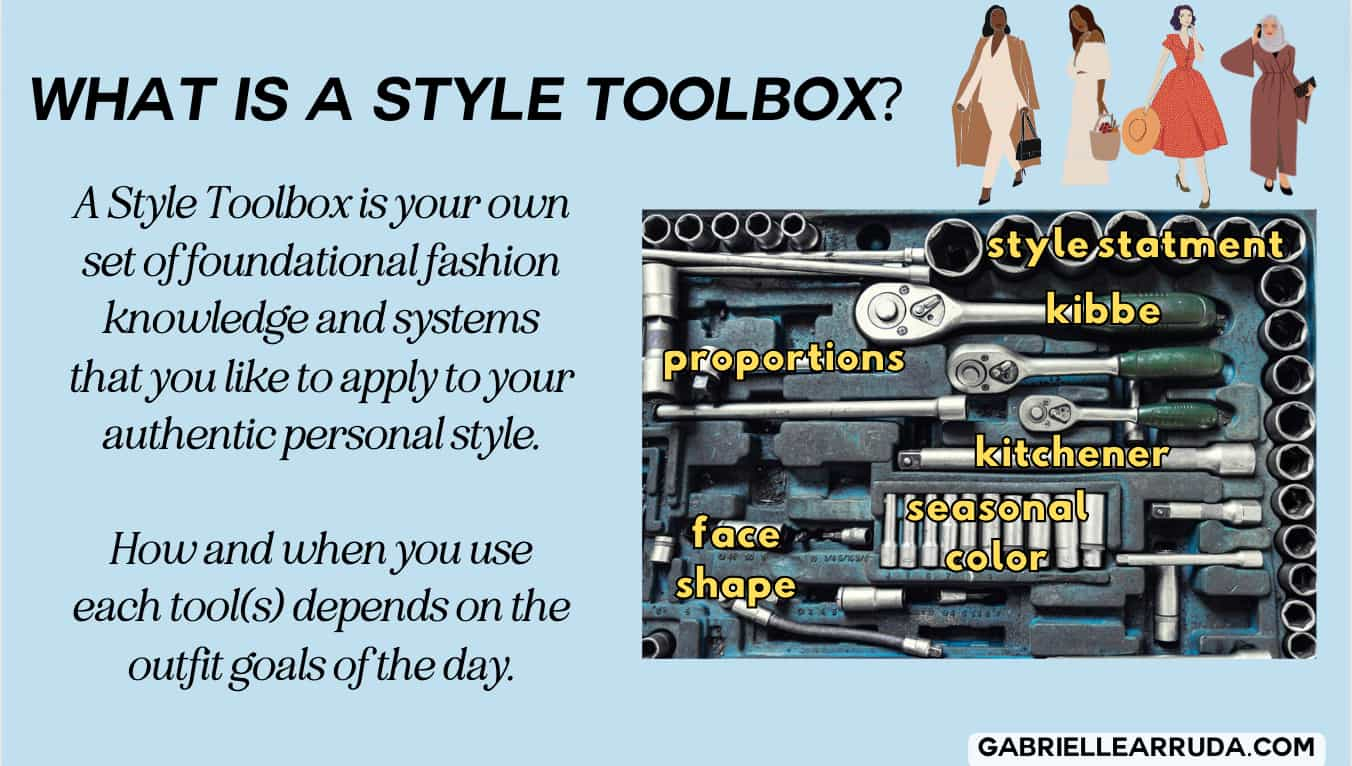
So if you are building an outfit outside your wheelhouse, like for a black tie event coming up but you typically wear very casual clothing, this could be challenging. However, you have a great handle on your style toolbox, and are starting to see how you want to express yourself so this new challenge is outside your competence level of today, but you get excited you can handle it. With, a bit of effort or trial and error. Or maybe experimenting with several different looks.
Versus, someone who has collected so much foundational fashion information but has not applied any of it to their unique style POV’s; they might get discouraged trying to build that black-tie outfit because they don’t have the data to understand their style priorities or the knowledge to know which tools will suit this task.
So, knowing your style toolbox (ahem, ep 1), very important.
But, here’s where this shooting for the moon, but landing among the stars thinking comes in.
Our brains, react well to desirable difficulties. So Hank Green was right when he said to shoot for about 80%, and then call it a day.
Shooting for 100% will lead to perfectionism and a lack of momentum to move forward and actually improve.
It’s like Newton’s law of inertia, an object in motion will stay in motion unless acted upon by an outside force. And an object at rest will stay at rest.
So if you never build the outfit, never apply the fashion information you’ve gathered, never take those daily outfit photos… well you are essentially “in rest”. You’re not doing anything to move your style in real life.
But, if you build the outfit, take the daily outfit photo, and just wear it even if it was only 80% there, you are now primed to move forward to the next outfit and your rate of progress is at least heading somewhere.
It may not be a perfect upward trajectory, but the beauty is, you’re going somewhere. And over time, and style data collection, you’ll find those nuggets of your style POV that really give you a big boost toward the goal post.
80% “Done” Through a Fashion Lens
But 80% good or done- what does that even mean in a style lens? And if you’re really in tune with your style should it be higher?
80% done means that it is communicating 80% of what you want it to.
Apparel and clothes are highly dependent on the person wearing them, the body they are draped on top of, the line drawing of the silhouette, the surface details, and the entire aesthetic expression or head-to-toe look.
Now, anyone who enjoys the Kibbe Image Identity System might have perked up at some of that terminology like “line drawings” or head-to-toe look.
Well, in this episode I’m not getting into his unique definitions of these concepts.
Exploring Apparel’s Role in Personality Perception
Instead, we are going to shift to the work of Marilyn DeLong. Ph.D., professor of apparel studies in the College of design at the University of Minnesota, the author of many in-depth books on design and color, and has published in many journals on the relationship between fashion, color, and our selves.
Note: these books are more theoretical and do not dictate style lines or have recommendations for a personal style journey, but they are very interesting if you like to deep dive!
One study, which I will link in the show notes. Evaluated the use of apparel as cues to the perceived perception of personality.
She had a group of women evaluate a collection of sweaters and place them in 5 different categories of interpretation. And I will also link the table results in the show notes.
But the groups were as follows. Does this sweater match the adjectives:
- Composed, Logical, Efficient
- Sophisticated, Polished, Mature
- Easygoing, Natural, Friendly
- Romantic, Sexy, Alluring
- Youthful, Spontaneous, Energetic
Don’t worry if you don’t remember those adjectives.
The women were asked to touch the garments, evaluate them, and then place within the group they perceived the sweater to fit into best.
They were not on a body, and they were not viewed within an outfit context. Just each sweater, on a hanger, is available to touch and examine, and then apply to a group.

Now, you can see the general results table in the show notes, but generally, they found the neckline, neck depth, waist length, tactile experience, and surface features to be important.
A line drawing, in the fashion sense, is the outline of a garment- which includes information like silhouette, neckline, or sleeve, but would not include surface details like color, texture, print or internal design details.
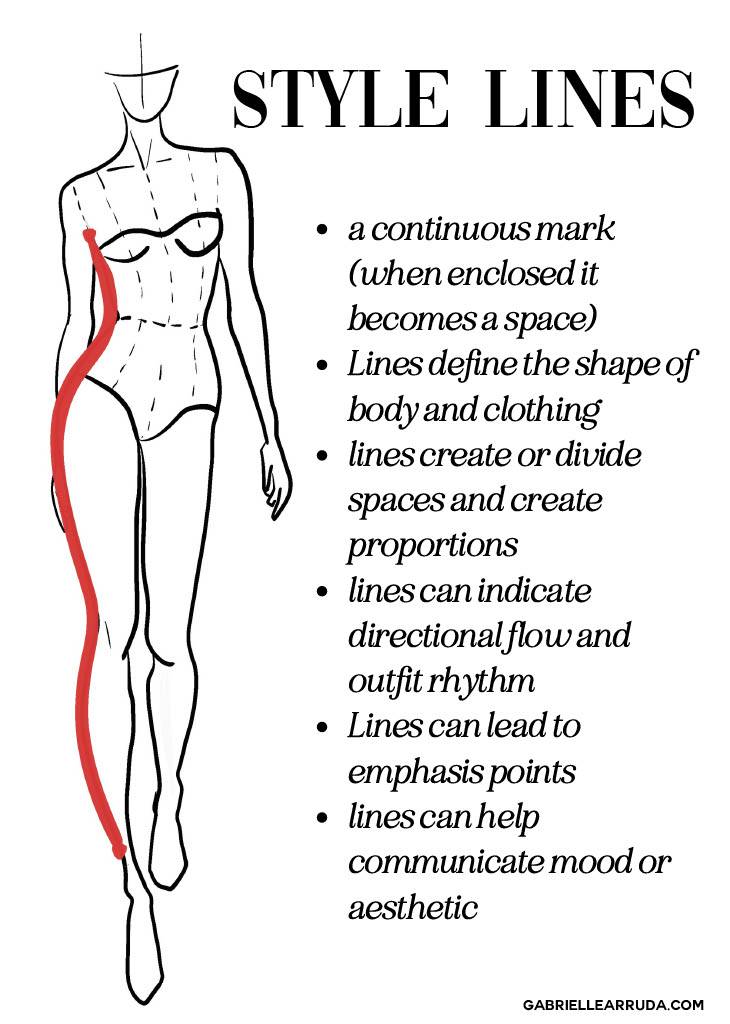
So, surface details were important to people being able to categorize the meaning of these garments…. Now, I’m not David Kibbe so this is my own opinion, but this is interesting to me- because he’s recently maintained that clothing doesn’t have IDs.
But, this experiment clearly finds, we do view the perception of the garment with cues to the personality or essence of the individual piece.
Here’s where it gets good. And this is an important tangent so stay with me here.
Marilyn Delong states “ a product separated from other contributors of meaning such as the body and other ensemble components, was perceived as a conveyor of messages about personality”.
Did you catch that” “ such as the body and other ensemble components”…
So, we could conclude (in a non-Kibbe sense) that yes clothing has innate messaging that people can interpret, but… we can also interpret that once those garments are on the body and the entire outfit is constructed and built, that message can change.
Why does this tie into style perfectionism?
Because, so many of us, are evaluating a piece outside of that context. We view a piece online, with the lens of “this is youthful, spontaneous, energetic” that will suit me! Instead of…
Does my lifestyle need this piece? Is it filling a wardrobe gap for me? How would it blend with my unique style POV, how would it suit my body, and how would I build entire looks around it?
Now, this is not in contradiction with anything David Kibbe has said. I just bring him up because these terms might be commonly thrown around in the Kibbe communities.
And I see a lot of analysis paralysis around “getting the recommendations right” or “nailing their image id”.
But, an object in motion, stays in motion.
Don’t throw up a style roadblock by overanalyzing one element of your outfit, or by falling back to a style you dislike just because this new information feels too hard.
Instead, we need to use the 80 or 85% rule.
Tackling Style Perfectionism with SMART Goals
Let’s talk about that in the context of a personal style lens.
We want to set a style goal that is 85% achievable, not so hard we can’t do it, but not so easy we have no conscious interest.
It’s the Goldilocks zone for sure.
The difficulty in stretching our own interpretations of what our styles can be, pushes us to move forward, pushes us to find our style goal post.
But, how do we set a style goal?
There is so much research on goal setting and goal productivity. And they all seem to love a good acronym.
The one I like for your style goal is the acronym:
SMART which stands for S- Specific, M- Measurable, A- Achievable, R-Relevant, and T-Time-bound.

And here’s what’s probably causing you to be stuck. You’re choosing goals you can’t necessarily control which causes issues with the M-measurable aspect and the A-achievable aspect, or you have absolutely zero S- specificity.
So, if your goal is to determine your image identity or body type for instance…
That may be specific, but is it the right goal? Because how will you know when you achieve it and how will you measure the success of the goal? And will that nomenclature really change how you feel in clothes?
Instead… I think a better goal would be: I’d like to learn more about how fabric interacts with the body so that I can determine my own unique style recipe that I feel good in and enjoy the look of. Because then any nuggets of information you learn and apply from those various style systems, becomes a win.
See how those two goals differ?
And, this is why you’ll hear me say again and again, take those daily outfit photos or videos so that you can start measuring your progress.
When you see all those outfits lined up, suddenly you start seeing what you like in your recipe and what you dislike. It gives you that forward momentum. Data, to evaluate and then try again tomorrow. And shoot for another 80% there outfit.
When you get so hung up on the nomenclature of a body type, or where you fall on this style spectrum or collect insane amounts of new style “boxes”, you lose sight of the goal….
Which is to express our style POV, love what we wear, and feel good in our clothes.
I encourage you to set a monthly, quarterly, and yearly style goal. They can all build upon each other…
For instance:
- Monthly: start taking daily outfit photos
- Quarter 1: Start seeking and evaluating data on what I want in my style toolbox
- Yearly: Feel better in my clothes, like the way I look in the mirror.
Great goals! Fantastic, you got this…
But, we’re better for being perfectionists? Right? Like it’s the one trait we jokingly attribute as our “greatest weakness’ as we slyly smile from our perfectly designed ivory towers.
Spoiler alert… The style perfectionism is going to thwart everything… Why? Because there is only one right answer in your head, and instead of moving forward you’re tweaking this or thinking about that, instead of applying it IRL.
You’re saying “I’ll do daily outfit photos when I have a good set up- a ring light, a better mirror, more time”… because ugly photos can’t help…
Wrong. The sooner you start this style 101 habit, the sooner you can tweak and optimize the efficiency in the habit, and even the ugly outfits or ugly photos help keep you in motion.
Perfectionism is stalling you, and maybe it’s a self-defense mechanism because you’re afraid to express your true style POV, and I get it. It’s scary to show the world who you are.
What if you’re judged? What if people don’t like it?
But, there’s also immense strength in this process. You find a voice, an expression, a strong sense of self that allows you to say
“ It’s ok if I’m not this person’s cup of tea, I like it”.
And boy is that an addicting feeling.
The Big Three of Perfectionism and How It Relates to Personal Style Building
Now The Big Three Perfectionism Scale– it’s a scientific test that describes perfectionism in three main categories (with technically 10 lower order facets as optional additions).
The three main topics are:
Rigid Perfectionism: This type of perfectionism involves strict adherence to one’s standards or rules. Individuals with rigid perfectionism may feel compelled to do things perfectly according to their own predefined criteria. They often have difficulty deviating from their plans or methods and may become anxious or frustrated when things don’t go exactly as planned.
Self-Critical Perfectionism: Self-critical perfectionism involves being excessively harsh or critical towards oneself. People with self-critical perfectionism tend to focus on their flaws, mistakes, or perceived shortcomings and may have a persistent fear of failure or making mistakes. This can lead to feelings of inadequacy, low self-esteem, and a constant sense of pressure to perform perfectly. “ If I get this right, they will love me.”
Narcissistic Perfectionism: Narcissistic perfectionism combines perfectionistic tendencies with traits of narcissism (duh); such as grandiosity, a need for admiration, and a lack of empathy. Individuals with narcissistic perfectionism may have an inflated sense of their own importance and expect others to recognize and praise their achievements. They may also be highly critical of others’ performance and dismissive of any feedback or criticism they receive.
Now, I think through the lens of style- we are dealing more with the self-critical perfectionism.
We tend to focus on our body image, our flaws, and our self-worth may be lowered in this arena due to not fitting what we consider the standard. A measure our brain has given us, for the ideal, not one rooted in an actual baseline assessment of good and bad.
And, here we are going to loop all of this back to the original posters Hank Green’s video.
How do we even define perfect? Or good?
Because what is good to my friend Sally, is not good to me, but might be neutral to Jane.
So, we need to loop it back to our “SMART” goal.
Does this outfit give me data to keep me moving towards my monthly, quarterly, or yearly SMART style goal.
And, if you are newer to your style journey, or newer to taking daily outfit photos, then I highly encourage you to write reflections on your outfits as well.
This can help you with the measurable aspect of the goal, and allow you to feel both stretched and excited for your future style goals.
Remember- we need those desirable difficulties to keep us seeking new challenges and moving forward.
Moving Your Style Journey Forward
Simply put- perfectionism is procrastination.
So, what are you afraid of?
We only get a certain amount of years on this earth, and I, for one, don’t want to spend any single day expressing a falsehood.
Let’s learn to trust our own fashion instincts, by achieving our SMART style goals.
Let’s learn that it’s ok to express OUR own unique stye POV.
And by doing that, we will find strength through style.
Thank you for tuning in, until next time.
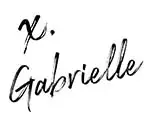
References:
- Hank Green Video
- Causes and consequences of perfectionism and procrastination: a structural equation model
- Use of Apparel as Cues to Perception of Personality (Marilyn Delong)
- The Eighty Five Percent Rule for optimal learning
- The Big Three Perfectionism Scale
- How To Write SMART Goals
Want to reference this episode again? Pin the below image:
